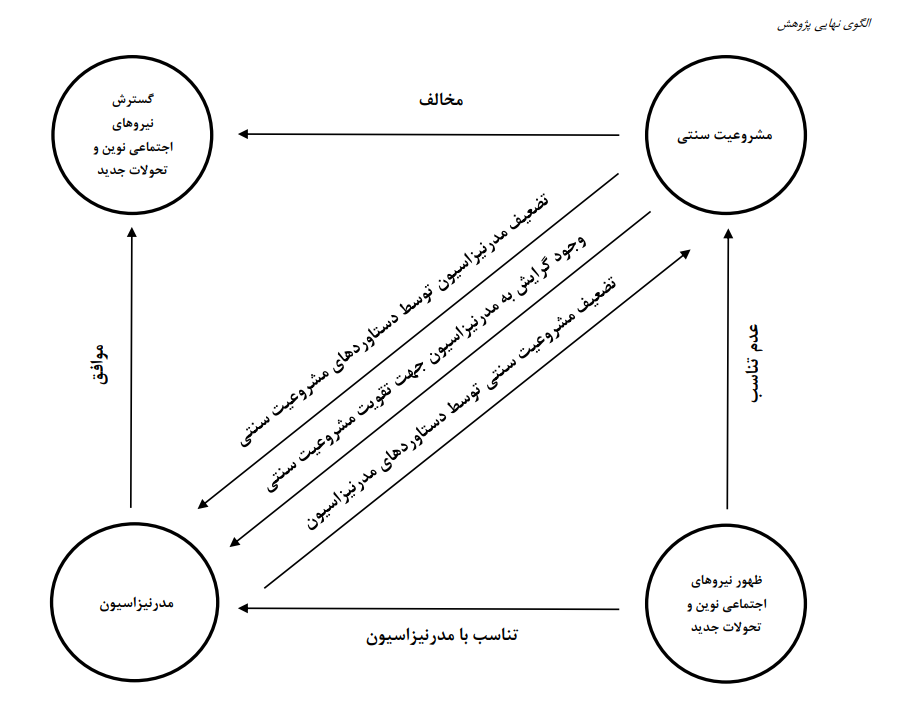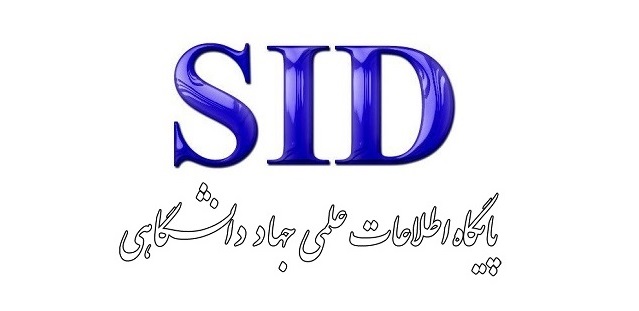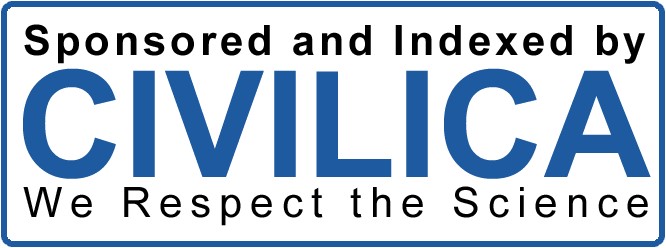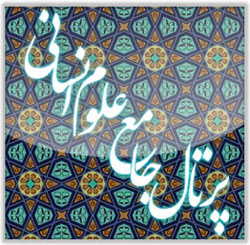مدرنیزاسیون پارادوکسیکال و نئوپاتریمونیالیسم در دوره پهلوی
کلمات کلیدی:
مدرنیزاسیون, مشروعیت سنتی, انقلاب اسلامی ایران, حکومت پهلویچکیده
این پژوهش به دنبال بررسی علل سقوط حکومت پهلوی، به عنوان حکومتِ نئوپاتریمونیالِ شبه مدرنِ وابستهای است که علیرغم وجود نوسازیهای اقتصادی و صنعتی، نتوانست به اقتداری پایدار دست یابد. نتایج این پژوهش نشان میدهد که میان فرایند مدرنیزاسیون و مشروعیت سنتی حکومت پهلوی، یک نوع ناسازگاری آشکار وجود دارد. در حالیکه حکومت پهلوی، بر یک ساختار نئوپاتریمونیالیستی استوار بود، شاه با تأکید بر توسعه اقتصادی و صنعتی، تلاش کرد تا همزمان با اصلاحات ارضی و گسترش خدمات اجتماعی، قدرت دولت مرکزی را تحکیم کند. بدیهی است که نتایج حاصله از فرایند مدرنیزاسیون با مبانی سنتی حکومت پهلوی، در تضاد قرار گرفت و منجر به ایجاد تعارضات داخلی و چالشهایی در سه سطح 1- گروهها و طبقات اجتماعی 2- هنجارها و ارزشهای سیاسی و اجتماعی 3- ساخت سیاسی-نهادی؛ شد. بر این اساس یکی از مهمترین عوامل وقوع انقلاب اسلامی، پارادوکس میان نئوپاتریمونیالیسم و مدرنیزاسیون است است. روش تحقیق در این مقاله، تحلیلی-توصیفی است. برای تحلیل، از نظریۀ مدرنیزاسیون وهمچنین مشروعیت سنتی ماکس وبر استفاده شده و گردآوری دادهها نیز کتابخانهای بوده است.
دانلودها
مراجع
Abrahamian, E. (2005). Iran Between Two Revolutions. Nashr-e Ney.
Abrahamian, E. (2010). A History of Modern Iran. Nashr-e Ney.
Akbari, M. A., & Beigdelou, R. (2011). Pahlavism: The Official Ideology of Mohammad Reza Pahlavi's Government in the 1960s and 1970s. Scientific-Research Quarterly of Ganjineh Ostadh(84), 6-25.
Azghandi, S. A. (2004a). The History of Political-Social Developments in Iran. SAMT.
Azghandi, S. A. (2004b). The Ineffectiveness of Iran's Political Elites Between Two Revolutions. Qom.
Baldwin, G. B. (1967). Planning an Development in Iran. Johns Hopkins Press.
Bashiriyeh, H. (2011). Political Sociology. Nashr-e Ney.
Bashiriyeh, H. (2015). Reason in Politics. Negah-e Mo'aser.
Behnoud, M. (1991). Iranian Cabinets from Seyyed Zia to Bakhtiar. Javidan.
Bill, J. (2004). The Pattern of Power Relations Among Iran's Political Elites. Farhang Andisheh Magazine Publications.
Coser, L., & Rosenberg, B. (2014). Fundamental Theories of Sociology. Nashr-e Ney.
Cottam, R. (1992). Nationalism in Iran. Kavir.
Eisenstadt, S. N. (1998). The Failures of Modernization. Arghanoon(13).
Foran, J. (1998). The History of Social Transformations in Iran. Rasa Cultural Services.
Fouladzadeh, A. (1990). The Pahlavi Monarchy in Iran (Vol. 2). Center for Publishing Islamic Thoughts.
Freund, J. (1993). Sociology of Max Weber. Rayzan.
Gasiorowski, M. J. (1992). U.S. Foreign Policy and the Shah. Rasa Cultural Services Institute.
Graham, R. (1979). Iran: The Illusion of Power. Sahab Ketab.
Green Miller, W. (1969). Political Organization in Iran: From Dowreh to Political Party. Middle East Journal, 23(3), 343-350.
Hajarian, S. (1993). The Imbalance of the Political Development Process in Peripheral Countries. Rahbord Quarterly, 2(2), 23-76.
Hajarian, S. (1995). The Structure of Sultanistic Authority. Political-Economic Information Magazine, 9(7 & 8), 45-57.
Hermassi, E. (1978). ''Changing patterns in Research on the Third world''. Annual Review of Sociology, 4, 239-257. https://doi.org/10.1146/annurev.so.04.080178.001323
Huntington, S. (1991). Political Order in Changing Societies. Elm.
Huntington, S. (1993). The Third Wave of Democracy at the End of the Twentieth Century. Rozaneh.
Katouzian, M. A. (1995). The Political Economy of Iran from the Constitutional Revolution to the End of the Pahlavi Dynasty. Nashr-e Markaz.
Katouzian, M. A. (2012). The Persians. Nashr-e Ney.
Katouzian, M. A. (2015). The Conflict Between State and Nation and the Theory of History and Politics in Iran. Nashr-e Markaz.
Lambton, A. K. S. (1969). The Persian land reform;1962-1966. Clarendon press.
Manzoor, D., & Yadipour, M. (2009). Experiences of Different Countries in Managing Oil Revenues and Lessons for Iran. Rahbord Quarterly(17), 143-165.
Norris, P., & Inglehart, R. (2004). Sacred and Secular: Religion and Politics Worldwide. Cambridge University Press. https://doi.org/10.1017/CBO9780511791017
Pahlavi, M. R. (1992). Answer to History. Shahrab.
Razavi, H., & Vakil, F. (1984). The Political Environment of Economic Planning in Iran: 1971-1983. Westview Press.
Saee, A. (2004). Political-Economic Issues of the Third World. SAMT.
Saee, A. (2009). Development in Conflicting Schools of Thought. Qom.
Saeedi, A. A. (2015). Technocracy and Economic Policymaking in Iran as Narrated by Reza Niyazmand. Lohe Fekr Publications.
Saikak, A. (1979). The Rise and Fall of the Shah 1941-79. Princeton University Press.
Seifzadeh, S. H. (1996). Modernization and Political Transformation. Qom.
Shajii, Z., & Fallaci, O. (1992). Iranian Political Elites from the Constitutional Revolution to the Islamic Revolution Interview with History Makers. Sokhan Publications Javidan.
Soodagar, M. R. (1990). Capitalist Relations in Iran (1963-1979). Sho'leh Andisheh.
Tornquist, O. (1999). POLITIS AND DEVLOPMENT. Sage publications.
Zabih, S. (1988). The Iranian Military in Revolution and War. Routdledge.
Zibakalam, S. (2008). Political and Social Developments in Iran (1941-1943). SAMT.
Zonis, M. (1991). Majestic Failure. Tarh-e No.

چاپ شده
ارسال
بازنگری
پذیرش
شماره
نوع مقاله
مجوز
حق نشر 2025 محمد ابوالفتحی (نویسنده); سید امیرحسین بنیاشراف (نویسنده مسئول)

این پروژه تحت مجوز بین المللی Creative Commons Attribution-NonCommercial 4.0 می باشد.








